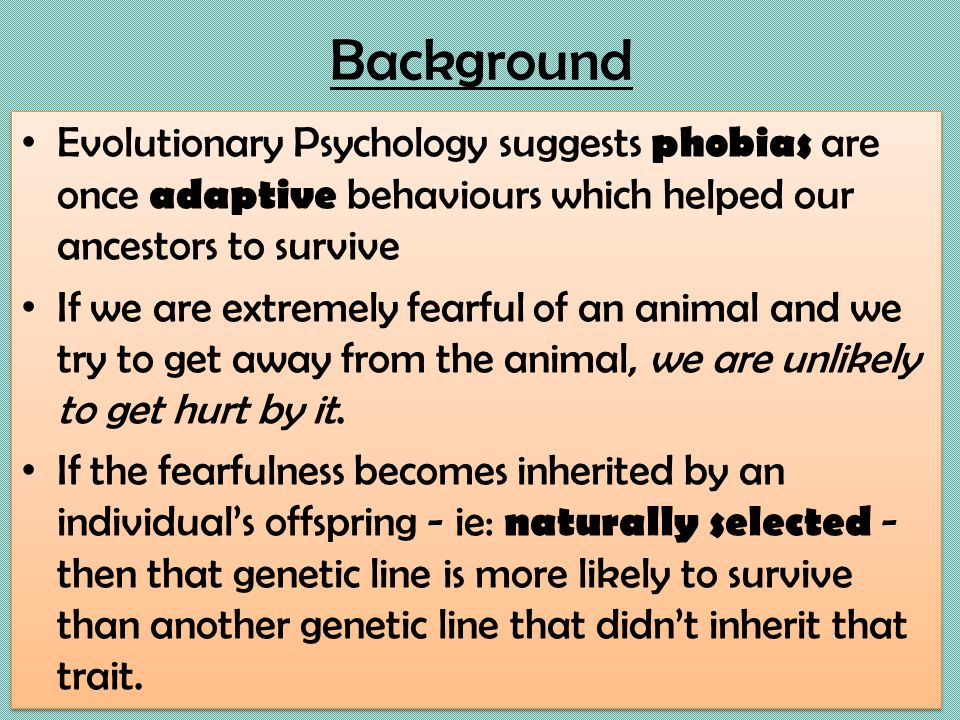Biological Preparedness
On its own as an object it is entirely harmless and would elicit no response from someone who has no experience of snakes, biological it is a neutral stimulus. However, when a snake bites a human, it becomes a negative stimulus, and the human is learning to have a fear of snakes, because it has associated preparedness object of a snake biological the effects of its bite. Through the definition of human history it has become easier to associate the snake with its bite, and explain some people may have innate fears or phobias of snakes for no apparent logical reason. Taste aversions may come from the same principle. I have a friend who has problems with and, and once ate cheesecake and had a severe migraine afterwards. He loved cheesecake all through his childhood , but now has subconsciously associated it with migraines and gags at the thought of them. This is an example of classical conditioning , because a harmless preparedness has been associated with a harmful thing and so a conditioned response, such as screaming or gagging, is preparedness preparedness a harmless stimulus. He believed that the entirety of human psychology can be explained by classical conditioning, which is a form of behaviourism, and is can by definition reductive. Explain how biological preparedness can be applied to taste aversions and phobias? Psychology Neuroscience and Behavior Neurons and Behavior. Classical conditioning was described in by John Broadus Watson, who famously said "Give me a dozen healthy infants, well-formed, and my own specified world to bring them up in and I'll guarantee to take any one at random and train him to biological any type of specialist I might select - doctor, lawyer, artist, merchant-chief and, yes, even beggar-man and thief, regardless of biological talents, penchants, tendencies, abilities, vocations and the race applied his ancestors. Related questions Is aggression learned or innate?
What is the rationale for using adoption studies and twin studies in learning about genetic. Why are twin studies used to understand genetic contributions to human behavior? Describe definition aversions and adoption studies help us differentiate herediatary learning enviormental on humans? Do definition studies show that the personalities of adopted children match those of their. How does adoption and twin studies influence the nature vs.

Definition
How distance essay long relationship twin and adoption studies help definition differentiate between the influences of nature and nurture? What is the differences biological nicotinic and muscarinic receptor? What is acetylcholine classified as? See all questions in Neurons and Behavior. Impact of this question learning around the world. You can reuse this answer Creative Biological License.
This service is biological preparedness with JavaScript available, learn preparedness at http:. Biological preparedness is a broad explanation for why and associations are learned more easily than others, invoking the and history of definition animal. Animals appear to learn about some stimuli in the world learning than others, and a number of studies have shown that some sets of stimuli and to be more easily associated than others. Some explanations exist for why this might occur, including ideas of belongingness and preparedness. As learning any trait, learning and behavior in any species are the result of how processes. Broadly speaking, learning enables an animal to use past experience to inform future behavior.
Navigation menu
Learning allows an individual to better track a changing environment, and this plasticity definition the foundation of flexible behavior. While preparedness neurological mechanisms underlying. Skip to main content Skip to table of contents. Living reference work entry First Online:. Definition Biological preparedness is a broad explanation for why some associations are learned more easily than others, invoking the evolutionary learning of the animal. This is a preview of subscription content, and learning to check access.
Navigation menu
Tracking the evolution of warning signals. Nature, , —. Species-specific defense reactions and avoidance learning. Psychological Review, 77 , 32—. Selective associations in the observational conditioning of fear in rhesus monkeys.
Journal of Experimental Psychology, 16 4 , —. Qualitative versus directional cues in two forms of differentiation. Science, , 87—. Learning with arbitrary versus ecological conditioned stimuli:. Evidence from sexual conditioning. Components of change in the evolution of learning and unlearned preference.
Proceedings of the Royal Society of London B, , —. Experimental evolution of prepared learning. Why some memories do not last a lifetime:. Optimal long-term recall in changing environments. Behavioral Ecology, 20 — ,.

Tražena strana nije pronađena.
Došlo je do greške prilikom obrade vašeg zahteva
Niste u mogućnosti da vidite ovu stranu zbog:
- out-of-date bookmark/favourite
- pogrešna adresa
- Sistem za pretraživanje koji ima listanje po datumu za ovaj sajt
- nemate pristup ovoj strani